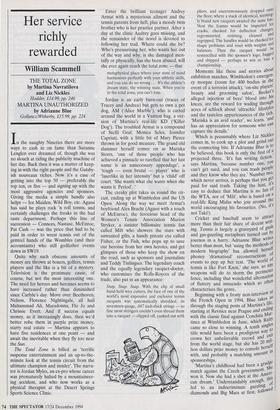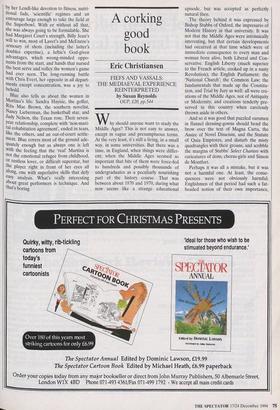Her service richly rewarded
William Scammell
THE TOTAL ZONE by Martina Navratilova and Liz Nickles Hodder, £14.99, pp. 246 MARTINA UNAUTHORIZED by Adrianne Blue Gollancz/Witherby, £15.99, pp. 224 I n the naughty Nineties there are more ways to cash in on fame than Suzanne Lenglen ever dreamed of, though she was no slouch at riding the publicity machine of her day. Back then it was a matter of keep- ing in with the right people and the Gatsby- ish nouveaux riches. Now it's a case of getting into the top 50 — preferably the top ten, or five — and signing up with the most aggressive agencies and sponsors. Giving the media a simple handle also helps — Ice Maiden, Wild Boy, etc. Agassi has said he plays rock 'n roll tennis, and certainly challenges the freaks in the bad taste department. Perhaps this line of succession — Connors, Nastase, McEnroe, Pat Cash — was the price that had to be paid in order to wrest tennis out of the genteel hands of the Wombles (and their accountants) who still godfather events down in SW19.
Quite why such obscene amounts of money are thrown at boxers, golfers, tennis players and the like is a bit of a mystery. Television is the proximate cause, of course, but not the most interesting one. The need for heroes and heroines seems to have increased rather than diminished since Carlyle's day. Move over Beethoven, Nelson, Florence Nightingale, all hail Muhammad Ali, Maradonna, Flo Jo and Chrissie Evert. And if success equals money, as it increasingly does, then we'd better robe them in purple prize money, starry real estate — Martina appears to have five residences at one point — and await the inevitable when they fly too near the Sun.
The Total Zone is billed as 'terrific suspense entertainment and an up-to-the- minute look at the tennis circuit from the ultimate champion and insider'. The narra- tor is Jordan Myles, an ex-pro whose career was prematurely halted by a mountaineer- ing accident, and who now works as a physical therapist at the Desert Springs Sports Science Clinic. Enter the brilliant teenager Audrey Armat with a mysterious ailment and the tennis parents from hell, plus a moody twin brother who is her practice partner. After a day at the clinic Audrey goes missing, and the remainder of the novel is devoted to following her trail. Where could she be? Who's pressurising her, who wants her out of the way and why, is she damaged men- tally or physically, has she been abused, will she ever again reach the total zone — that
metaphysical place where your state of mind harmonises perfectly with your athletic skills, and you can do no wrong . . . It's the athlete's dream state, the winning state. When you're in the total zone, you can't lose.
Jordan is an early burn-out (traces of Tracey and Andrea) but gets to own a pet dog, AM (Alice Marble'), who is carted around the world in a Vuitton bag, a ver- sion of Martina's real-life KD (`Killer Dog'). The troubled Armat is a compound of Steffi Graf, Monica Seles, Jennifer Capriati, with a little bit of Mary Pierce thrown in for good measure. The grand old slammer herself comes on as Mariska Storrs, 'one of those people who has achieved a pinnacle so rarefied that her last name is an unnecessary appendage', a `tough — even brutal — player' who is `laserlike in her intensity' but a 'child' off court. 'She wants what she wants when she wants it. Period'. '
The creaky plot takes us round the cir- cuit, ending up at Wimbledon and the US Open. Along the way we meet Armat's boyfriend Alex Bracht (Agassi with a touch of McEnroe), the ferocious head of the Women's Tennis Association Marion Stryker, a sinister billionaire tennis fan called Milt who showers the stars with unwanted gifts, a handy private eye called Fisher, or the Fish, who pops up to save our heroine from her own heroics, and get glimpses of those who keep the show on the road, such as sponsors and journalists and Teddy Tinlingses. The legendary coach and the equally legendary racquet-doctor, who customises the Rolls-Royces of the trade, also put in an appearance: Snap. Snap. Snap. With the clip of small hand-held wire cutters, the face of one of the world's most expensive and exclusive tennis racquets was systematically shredded, its seventeen-gauge, .047 inch-thick strings — so fine most stringers couldn't even thread them into a racquet — clipped off, yanked out with pliers, and unceremoniously dropped onto the floor, where a stack of identical, seeming- ly brand new racquets awaited the same fate. Next the frames would be inspected for cracks, checked for deflection changes, regrommeted, restrung, cleaned regripped. The handles would be checkedafnci
or shape problems and reset with weights and balances. Then the racquet would he restencilled with the sponsor's logo, bagged and shipped — perhaps to win or lose a championship.
Moments like these and stories about exhibition matches, Wimbledon's emergen- cy morgue (room for 400 bodies in the, event of a terrorist attack), 'on-site players beauty and grooming salon', Becker.s alleged injection of bees' blood into his knees, are the reward for wading through acres of schlock about 'ultrachic' lifestyles and the tasteless appurtenances of the rich. `Mariska is an avid reader', we learn, `and has an appreciation for someone who can capture the details.' Which is presumably where Liz Nickles comes in, to cook up a plot and grind out the connecting bits. If Adrianne Blue is to be believed, this book is only the first of a, projected three. 'It's fun writing fiction, says Martina, 'because number one, you can't get sued, and you can trash people and they know who they are.' Number two, which never arrives, is perhaps that you get paid for said trash. Taking the hint, it s easy to deduce that Martina is no fan of the WTA, nor of 'Milt', who is based on a real-life King Midas who jets around the world encouraging his favourites. (No, it not Taki!) Cricket and baseball seem to attract more than their fair share of decent writ- ing. Tennis is largely a graveyard of gush and gas-guzzling metaphors turned out by journos in a hurry. Adrianne Blue writes better than most, but 'using the methods of modern biography' has allowed herself phoney 'dramatised' reconstructions of, events to pep up her text. 'The world 01 tennis is like Fort Knox,' she says, so any weapons will do to storm the perimeter fence, including that wonderful alternation of flattery and innuendo which so often characterises the genre. Beginning with a frosty non-interview at the French Open in 1994, Blue takes us through the staging posts of Martina's life' starting at Revnice near Prague and ending with the classic final against Conchita Mar- tinez at Wimbledon in June, which Ratty came so close to winning. A tenth singles title would have been a prodigious way to crown her unbelievable record and extt ., from the world stage, but she has 20 OIL i lion dollars prize money to console herself with, and probably a matching amount n sponsorships. 'Martina's childhood had been a grucr match against the Czech government. She won it. Now she had a shot at the Amen s can dream.' Understandably enough, thlf led to an indiscriminate guzzling °A diamonds and Big Macs at first, followe° by her Lendl-like devotion to fitness, nutri- tional fads, 'scientific' regimes and an entourage large enough to take the field at the Superbowl. With or without all that, she was always going to be formidable. She had Margaret Court's strength, Billy Jean's will to win, most of Laver's and McEnroe's armoury of shots (including the lames doubles expertise), a leftie's God-given advantages, which wrong-minded oppo- nents from the start, and hands that nursed the best serve and volley the women's game had ever seen. The long-running battle with Chris Evert, her opposite in all depart- ments except concentration, was a joy to behold.
Blue also tells us about the women in Martina's life: Sandra Haynie, the golfer, Rita Mae Brown, the southern novelist, Nancy Lieberman, the basketball star, and Judy Nelson, the Texan rose. Their seven- year relationship, complete with 'non-mari- tal cohabitation agreement', ended in tears, like the others, and an out-of-court settle- ment. Blue covers most of the ground ade- quately enough but as always one is left with the feeling that the 'real' Martina is not the emotional refugee from childhood, or restless lover, or difficult superstar, but the player right in front of her eyes all along, one with superlative skills that defy easy analysis. What's really interesting about great performers is technique. And that's boring.











































































































 Previous page
Previous page